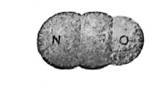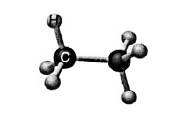
Concept explainers
a)
Interpretation:Formula, name and molecular mass of the below mentioned molecules should be written.

Concept introduction:In the molecular formula, the exact number and type of constituent atoms are shown. Type of constituent atoms is represented by their atomic symbols and number of each constituent atom is represented in the right subscript of its atomic symbol. In a hypothetical molecule
Formula to calculate molecular mass of
b)
Interpretation: The formula, name and molecular mass of the below mentioned molecules should be written.

Concept introduction: In the molecular formula, the exact number and type of constituent atoms are shown. Type of constituent atoms is represented by their atomic symbols and number of each constituent atom is represented in the right subscript of its atomic symbol. In a hypothetical molecule
Formula to calculate molecular mass of
Want to see the full answer?
Check out a sample textbook solution
Chapter 2 Solutions
Principles of General Chemistry
- Determine how many atoms, molecules or formula units are in each of the following: a 7.75moles of methane, CH4 b 0.0888mole of carbon monoxide c 57.8moles of iron d 0.81mole of magnesium chloridearrow_forwardIn what units are atomic, molecular, and formula mass expressed? Define those units.arrow_forwardWhat is the total mass (amu) of carbon in each of the following molecules? CH4 CHCl3 C12H12O6 CH3CH2CH2CH2CH3arrow_forward
- Determine the molecular mass of the following compounds:arrow_forwardSuppose Avogadro’s number was 1000 instead of 6.0221023 . How, if at all, would this affect the relative masses on the periodic table? How, if at all, would this affect the absolute masses of the elements?arrow_forwardCalculate the formula mass of calcium carbonate.arrow_forward
- Calculate the formula mass of N2H4 to 2 decimal places.arrow_forward(a) 1. Average atomic mass in amu off one iron atam. 55.847 amu (b) Using the amu, calculate the mass, in amu, in 133 iron atoms (C) How many iron atoms are present in a mass sample of 7428 amu lof iron that has aarrow_forwardWhat does this mass spec say about the molecular formula of the molecule?arrow_forward
 Chemistry by OpenStax (2015-05-04)ChemistryISBN:9781938168390Author:Klaus Theopold, Richard H Langley, Paul Flowers, William R. Robinson, Mark BlaserPublisher:OpenStax
Chemistry by OpenStax (2015-05-04)ChemistryISBN:9781938168390Author:Klaus Theopold, Richard H Langley, Paul Flowers, William R. Robinson, Mark BlaserPublisher:OpenStax World of Chemistry, 3rd editionChemistryISBN:9781133109655Author:Steven S. Zumdahl, Susan L. Zumdahl, Donald J. DeCostePublisher:Brooks / Cole / Cengage Learning
World of Chemistry, 3rd editionChemistryISBN:9781133109655Author:Steven S. Zumdahl, Susan L. Zumdahl, Donald J. DeCostePublisher:Brooks / Cole / Cengage Learning Introductory Chemistry: An Active Learning Approa...ChemistryISBN:9781305079250Author:Mark S. Cracolice, Ed PetersPublisher:Cengage Learning
Introductory Chemistry: An Active Learning Approa...ChemistryISBN:9781305079250Author:Mark S. Cracolice, Ed PetersPublisher:Cengage Learning- Chemistry: Matter and ChangeChemistryISBN:9780078746376Author:Dinah Zike, Laurel Dingrando, Nicholas Hainen, Cheryl WistromPublisher:Glencoe/McGraw-Hill School Pub Co
 Introductory Chemistry: A FoundationChemistryISBN:9781337399425Author:Steven S. Zumdahl, Donald J. DeCostePublisher:Cengage Learning
Introductory Chemistry: A FoundationChemistryISBN:9781337399425Author:Steven S. Zumdahl, Donald J. DeCostePublisher:Cengage Learning





